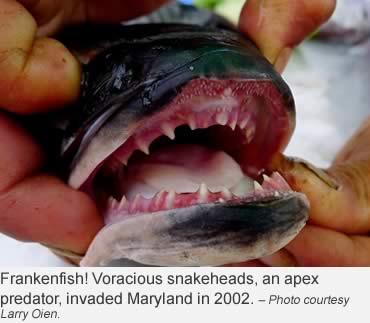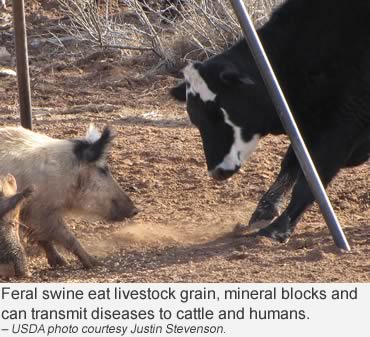Beware and Be Aware—it’s spooky so many invasive species live among us, spoiling the land, water and skies. Accidentally or purposefully imported, introduced or escaped, they’ve multiplied and thrived while native species have suffered or disappeared.
Conservationists have learned the best defense is to create awareness and educate the public about invasives. Some are new arrivals. Some were imported to solve a problem, then created new or worse problems. Others escaped from the pet trade or their owners, and some have been here so long we think they are native.
A few rare invasives cause no significant economic or ecological damage, but others require stringent controls, at a cost counted by billions. It is an old story, and it began centuries ago.
On the who’s who list of invaders, feral swine rank among the most devastating. Introduced to America in the 1500s by early explorers and settlers as a take-along food source, a few escaped. They’ve been multiplying ever since. By one estimate, feral hogs cause $2.5 billion in damage annually to the U.S. native ecosystems, preying on or competing with native species, spreading diseases.
Nutria, rodents of unusual size (R.O.U.S.), rank with other infamous invasives for their negative impact on marshes. They arrived in 1889 from South America, prized for their fur. Now they outcompete native wildlife and destroying their habitat.
 The innocent, invasive dandelion arrived with Mayflower in 1620, an edible plant transported to the New World as medicine for skin, liver and digestive ailments.
The innocent, invasive dandelion arrived with Mayflower in 1620, an edible plant transported to the New World as medicine for skin, liver and digestive ailments.
Old World House Sparrows were imported in the 1850s to protect the city of Brooklyn’s basswood trees from Linden moth caterpillars. The sparrows ate so many, more were imported. Today, 80 million house sparrows live coast to coast.
Common European starlings arrived in 1890 with a German immigrant who wished to populate America with birds Shakespeare mentioned in his plays and poems. Today, skies are filled with an estimated 200 million starlings.
Brown tree snakes have overrun the U.S. Territory of Guam. They slithered off ships from the Solomon Islands in the 1940s and 50s. Currently, with some controls in place, residents of the small island co-exist uncomfortably with 29 or more snakes per acre of land.
Large populations of Burmese Pythons were found in Florida’s Everglades in the 1990s, but pythons had been sighted since the 1930s. The voracious Burmese invasives escaped from breeding facilities after hurricanes, others were imported, escaped or released as pets. In Florida’s welcoming climate, their number exploded.
 Alligators and man are their only enemies.
Alligators and man are their only enemies.
If located in the wrong place, a native species can be invasive. Rusty Crayfish found in Wisconsin in the 1960s signaled an invasion. Once used as lived bait, the Southern states natives flourished in waters with fewer native species to prey upon them.
Lionfish, for which Floridians now hold fishing derbies, were released or escaped from aquariums. Their venomous spines mean they have no natural predators. Sadly, they are also present in Hawaii.
Asian carp, with a spectacular habit of leaping out of rivers and injuring boaters, were imported in the 1970s to control algal blooms in wastewater treatment plants and fishponds in the Southern U.S., but they escaped.
Biologists intensely fear their northern river migration to the Great Lakes. Illinois promotes eating them in sandwiches.
Dubbed Frankenfish, the snakehead, also a tasty invader, is a voracious Asian freshwater fish. Discovered in a Maryland pond in 2002, the apex predator had been sold as a food source and in pet stores.
Invasive plants spread as trees, flowers, shrubs, grasses and vines. Two notables are kudzu and tumbleweed.
Kudzu, The Vine That Ate The South, introduced as an ornamental at the 1876 Philadelphia Exposition, gained practical use in the 1930s for erosion control. Once established, it can grow a foot a day and quickly spreads. Diligent mowing and herbicides control it.
Tumbleweed, an iconic symbol of the wild West is not a native plant. It was introduced in the 1870s with imported Russian flaxseed contaminated with Kali seed in South Dakota. It is now found throughout North America.
 Invasive creepy crawlies are numerous. Some conservationists work frantically to control emerald ash borers that threaten the U.S. ash lumber industry, while others focus on Hemlock wooly adelgids projected to kill most Eastern Hemlocks in the next decade if not controlled.
Invasive creepy crawlies are numerous. Some conservationists work frantically to control emerald ash borers that threaten the U.S. ash lumber industry, while others focus on Hemlock wooly adelgids projected to kill most Eastern Hemlocks in the next decade if not controlled.
Dangerous Africanized bees arrived in the 1960s from Brazil; destructive Formosan termites were unloaded in Houston in the 1940s, and fire ants disembarked in soil shipments from South America in 1910.
America is overwhelmed, but what can anyone do to control invasives? A mobile phone is a good starting place to monitor them.
The University of Georgia Center for Invasive Species and Ecosystem Health and the U.S. Forest Service have created the free app Wild Spotter, available on Google Play and Apple app stores. By tracking non-native plants in wild places, the app provides information protect wild places from non-native plants, pathogens and animals which threaten biodiversity and health of every aquatic and terrestrial ecosystem. Take it along on your next hike or hunting trip.
– Resources: USDA, US Forest Service.